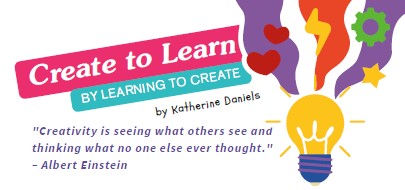
4 minute read
Create to Learn By Learning To Create
"Creativity is seeing and thinking what no one else ever thought." - Albert Einstein
To create or make is not just about the final by product of a person’s time spent or talent applied. It’s all about the process that takes them through, from start to end. By providing your kiddos, and even you, the space to be in the moment of creating and making, you open up new worlds and possibilities, both mentally and physically, nurturing a positive foundation of self-confidence and mental health.
Introducing children to creative classes and learning laboratories offers many benefits that contribute significantly to their academic and personal development. These environments educate and inspire children to explore their interests, develop new skills, and engage with the world innovatively. The impact of such educational experiences can be profound, fostering creativity, critical thinking, and a love of learning that will serve them throughout their lives.
Creative classes come in many forms, and each has its unique benefits. For example, art classes, including painting, drawing, and sculpture, enhance fine motor skills, improve visual learning, and encourage non-verbal expression and communication.
Music classes, whether instrumental or vocal, boost memory and language skills and cultivate patience and discipline. Drama and theater programs improve verbal and non-verbal communication, enhance empathy, and build confidence. Dance classes promote physical fitness and coordination and teach the importance of perseverance and teamwork. Creative writing and storytelling workshops improve literacy and vocabulary, encouraging imaginative thinking and personal expression.
On the other hand, learning laboratories offer a hands-on, experiential approach to education, allowing children to explore scientific concepts, technology, engineering, and mathematics (STEM) in an interactive environment.

Robotics labs teach programming skills, logical thinking, and problem-solving. Science labs make abstract concepts tangible, fostering curiosity and analytical skills. Coding and game design workshops introduce children to the basics of software development and digital creativity, preparing them for a digitally driven world. Maker spaces encourage innovation and design thinking, allowing children to bring their ideas to life through 3D printing, electronics, and construction projects.
"You can't use up creativity. The more you use, the more you have." - Maya Angelou
Where To Start
Step 1— Align the creative activities with the children's interests. Kids are likelier to engage in tasks that resonate with their passions and curiosities.

Step 2—Encourage them to explore and experiment without the fear of making mistakes. By creating a positive environment, they will build self-esteem and feel more comfortable learning to be creative.
Step 3—Allow them to choose their experience. When kids feel they have control over their learning, they are more likely to be invested in the process and take pride in their achievements.
Here are a few local spaces you should consider for the next creator or maker adventure:
Arkansas Museum of Fine Arts - arkfa.com
Arkansas Regional Innovation Hub - arhub.org
Central Arkansas Library System - cals.org
iCode School - icodeschool.com/littlerock
Museum of Discovery - museumofdiscovery.org
The Muddy Pig - muddypigstudio.com
The Painted Pig - paintedpigstudio.com
UALR Donaghey College STEM Summer Camps - ualr.edu/cstem

#familyfun #summerfun #summercamps #Arkansasfamilies #playtime

To create or make is not just about the final bypro duct of a person’s time spent or talent applied. It’s al so about the process that takes them through, from sta rt to end. By providing your youth, and even you, the space to be in the moment of creating and making, you open up new worl ds and possibilities, both mentally and physically, nurtur ing a positive foundation of self-confidence and mental h ealth.



